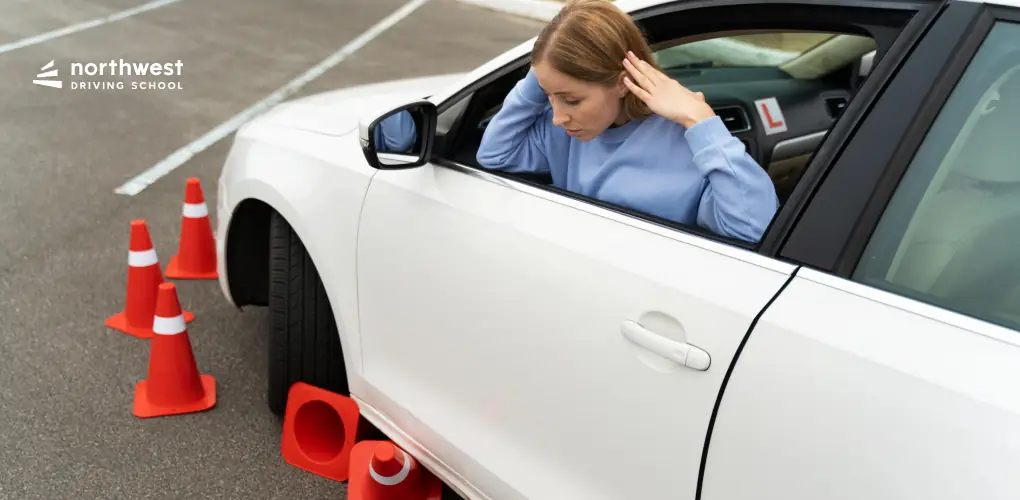- Driving School
The Most Common Driving Test Faults And How You Can Avoid Making Them. Part: 2

Failing your driving test can be a frustrating and disappointing experience. Not only does it mean that you have to go through the process all over again, but it can also delay your independence and freedom on the road.
Fortunately, there are ways to increase your chances of passing the driving test on your first try. By familiarizing yourself with the most common driving test faults and learning how to avoid them, you can approach your test with confidence and improve your chances of success.
Read More: The Most Common Driving Test Faults And How You Can Avoid Making Them. Part: 1
Table of Contents
Not checking mirrors frequently enough
One of the most common driving test faults is not checking mirrors frequently enough. This can lead to missing important information on the road, such as other vehicles, pedestrians, or hazards.
To avoid this fault, make a conscious effort to check your mirrors every 5-8 seconds. This will ensure that you are aware of your surroundings and can make informed decisions while driving.
Incorrectly positioning during turns
Another common fault is incorrectly positioning the car during turns. This could involve turning from the wrong lane, cutting corners, or failing to stay within your lane.
To prevent this mistake, always approach turns with caution and follow the correct procedures for signaling and positioning. Remember to stay in the correct lane and use reference points to help you stay within your lane during turns.
Not using proper observation techniques
Proper observation is crucial for safe driving, yet it is another common fault on driving tests. This can include failing to check blind spots, not using mirrors effectively, or not anticipating potential hazards.
To avoid this fault, practice regularly checking your blind spots and using your mirrors effectively. Anticipate potential hazards by scanning the road ahead and staying aware of your surroundings.
Lack of confidence
Lack of confidence is not a specific fault on the driving test, but it can hinder your performance and increase the chances of making other mistakes. Nervousness and anxiety can cause you to forget important procedures or make errors that you wouldn’t normally make.
To build your confidence, practice regularly with a licensed driver and familiarize yourself with the test route. Additionally, try to stay calm and focused during your test by taking deep breaths and reminding yourself of your skills.
The wrong steering technique
Using the wrong steering technique is another common mistake on driving tests. This could involve over-steering, not using hand-over-hand steering, or not keeping both hands on the wheel.
To avoid this fault, practice proper steering techniques and remember to use hand-over-hand steering when making turns or correcting your course. Keep both hands on the wheel at all times to maintain control of the vehicle.
Junctions and roundabouts
Junctions and roundabouts can be challenging for new drivers, and they are often a source of mistakes on driving tests. Common faults include not signaling properly, failing to give way or yield, or not maintaining the correct speed.
To avoid these faults, practice approaching junctions and roundabouts with caution. Remember always to signal appropriately, give way or yield when necessary, and maintain a safe speed.
Response to signs and signals
Another common fault on driving tests is not responding correctly to signs and signals. This can include missing or ignoring road signs, not obeying traffic lights, or failing to respond to other drivers’ signals.
To avoid this mistake, always be alert for road signs and signals, and make sure to follow them accordingly. Stay aware of your surroundings and anticipate the actions of other drivers based on their signals.
Steps to take to pass your test on the first try
Now that you are familiar with some of the most common driving test faults, here are some general steps you can take to increase your chances of passing on your first try:
- Choose NWDS as your driving school. They are an incredible driving school that has a high success rate in getting its students to pass the test on the first try.
- Practice regularly with a licensed driver and get comfortable behind the wheel.
- Familiarize yourself with the rules and regulations of the road.
- Study and practice proper driving techniques, such as signaling, lane positioning, and observation.
- Take a mock driving test to simulate the actual test experience and identify any areas that need improvement.
- Get enough rest before your test day to ensure you are alert and focused during the exam.
- Stay calm and confident during your test. Remember that nerves can hinder your performance, so try to relax and trust in your skills.
By following these steps and being aware of common driving test faults, you can improve your chances of passing your test on the first try. Remember to stay focused, practice regularly, and don’t let mistakes discourage you. With determination and perseverance, you’ll soon be on the road as a licensed driver. So keep practicing, and good luck on your driving test!


